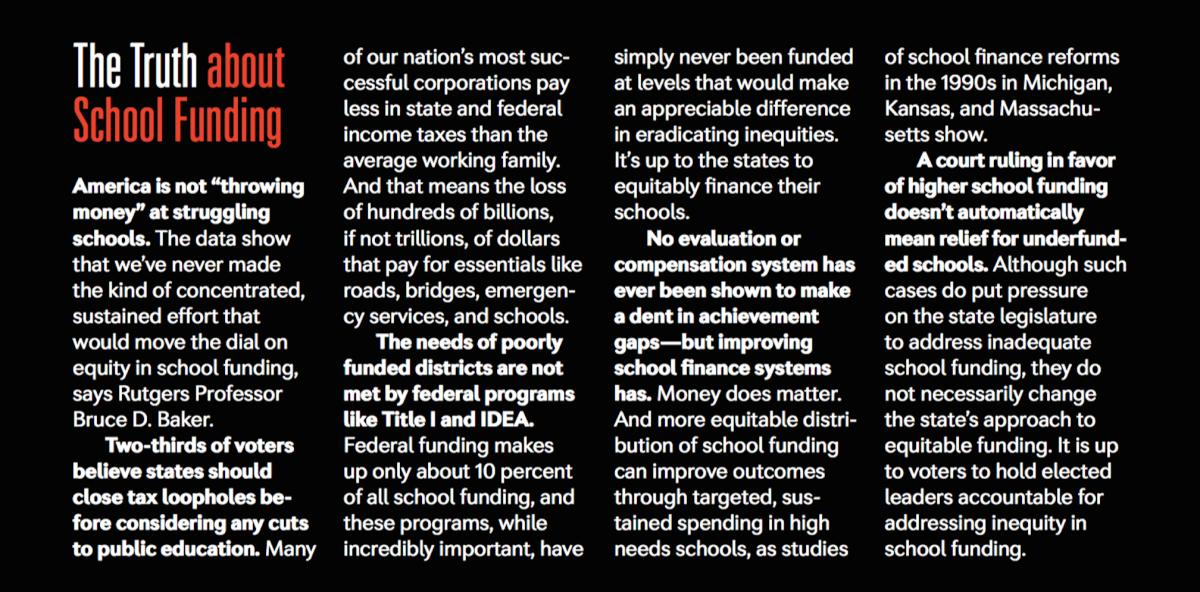This article is the first in a NEA Today series that explores obstacles to education that create an opportunity gap for disadvantaged students. With the number of children living in low-income families reaching record highs, these issues are affecting more communities across America and the public schools that serve them.
_____________________________________________
In a kindergarten classroom at Riverside Elementary School in Reading, Pa., one of the 5-year-olds seated cross-legged on the rug is so eager to be called on it looks as if his arm is being pulled from above. His teacher, Lori Sherman, has just read them a book about the rainforest and asked if anyone remembers the word for the characteristic that allows animals to blend into their surroundings.
Finally, his name is called.
“Mosiah?” “Camouflage!” he says through a smile.
In a trailer at nearby 12th and Marion Elementary School, a fourth grader who knows the difference between prime and composite numbers nearly topples her chair backwards in her enthusiastic bid to give the answer.
Happy moments like these occur every day in U.S. public schools. But they are even more heartening when witnessed against the bleak backdrop of Reading, where students and educators confront barriers to learning every day—some exacerbated by the gross underfunding of their schools, others the result of it.
Reading is one of the nation’s poorest cities. It’s also one of the most poorly funded school districts in America. Like students in disadvantaged communities across the nation—who are disproportionately students of color—kids in Reading suffer from a school finance policy that does not come close to providing them with education resources on par with those of their wealthier peers.
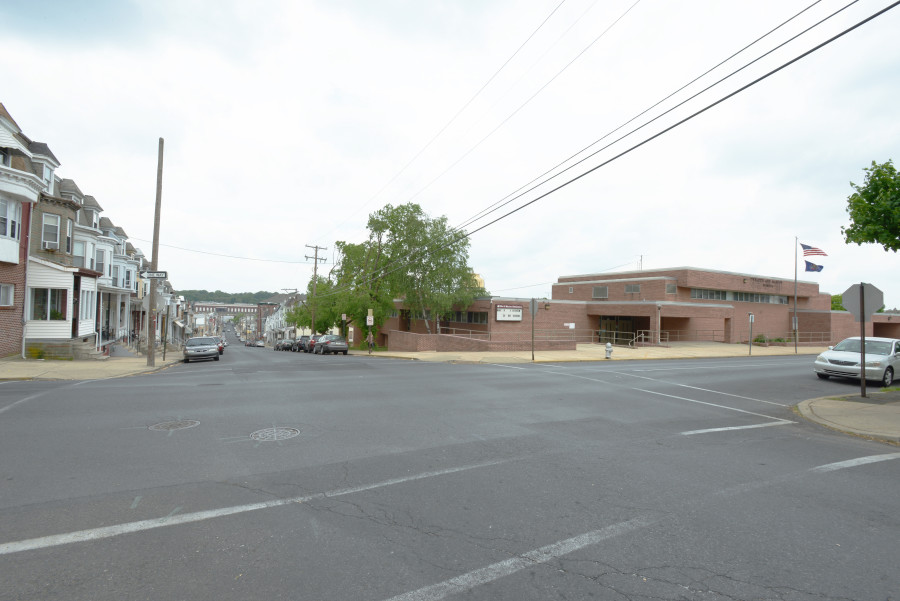 Reading is one of the most poorly funded school districts in the United States.
Reading is one of the most poorly funded school districts in the United States.
Tour Reading’s 19 schools and you’ll see mostly aging buildings with broken floor tiles, leaky ceilings sprouting patches of mold, students crammed into too-small classrooms, and feral cats squatting under classroom trailers. One high school has a room full of broken microscopes, and no money to repair them. One large-group instruction room is completely off limits after a broken pipe left it spattered with sewage. The drama teacher now conducts class in the hallway.
But even more detrimental is what you don’t see.
Reading School District lost 200 educators, including 120 education support professionals in 2011 – 2012 when statewide education funding plummeted by $1.1 billion under then-Gov. Tom Corbett. Incredibly, the cuts were four times greater in Pennsylvania’s 50 poorest districts ($532 per student) than in the state’s wealthiest districts ($113 per student).
In practical terms, those cuts left Riverside Elementary’s Ms. Sherman with a class of more than 30 kinder- garteners and no aide. Many of her colleagues also saw their class sizes balloon, reducing precious one-on-one time that is essential for disadvantaged children.
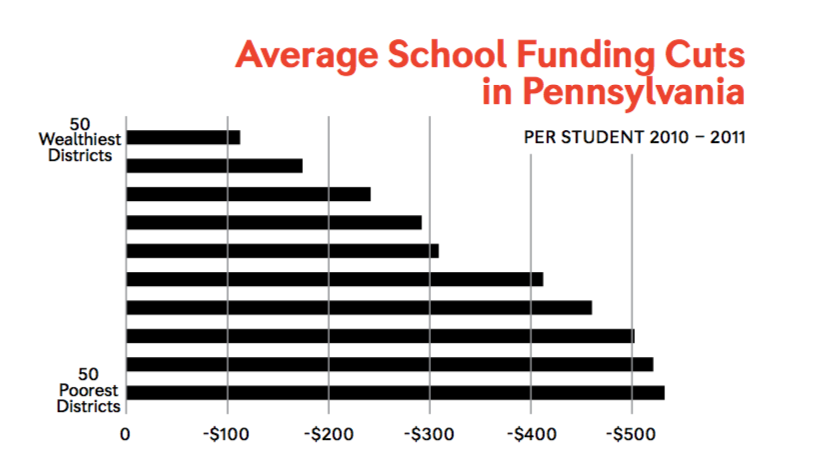 Mosiah doesn’t have art, gym, or music and there is only one 15-minute recess that is largely spent getting outside and lining up to go back in. There’s no longer a separate kindergarten class focused on meeting special needs among his peers.
Mosiah doesn’t have art, gym, or music and there is only one 15-minute recess that is largely spent getting outside and lining up to go back in. There’s no longer a separate kindergarten class focused on meeting special needs among his peers.
Things are very different in the wealthier (and whiter) districts that lie outside of Reading, whose student body is 90 percent children of color.
Just a mile and a bridge away, Wyomissing Area School District—where 77 percent of students are White—spends a whopping $4,000 more per pupil each year. Students attend bright and modern schools, have a rich curriculum, and smaller class sizes. About 50 percent of high school students take AP courses, compared to just 10 percent of students at Reading High School. They also have more stable home lives and enter school with fewer unmet basic needs.
“One of my close friends went to a wealthier district after working in Reading for 10 years,” says Sherman. “At the same step on the pay scale she was earning $16,000 more per year, and had a kindergarten class of 18 with an aide, while I had a class of 30 kindergartners all on my own. It’s a big difference.”
Let’s be clear: The kids in Wyomissing should have smaller class sizes, challenging academics, and extracur- riculars like sports, band, and orchestra. They should have access to a nurse and a counselor and all the aca- demic supports they need.
But students in Reading should have those things, too.
“The kids here are bright, energetic, and motivated,” says Reading Education Association President Mitch Hettinger, who spent much of his 30-plus-year career teaching the city’s middle schoolers. “They just have the unfortunate circumstance of living in the wrong ZIP code.”
Research shows that students in districts with concentrated poverty benefit greatly from high-quality early childhood education, tutoring, ELL programs, dropout prevention measures, and other services, and they need more of them than their wealthier peers.
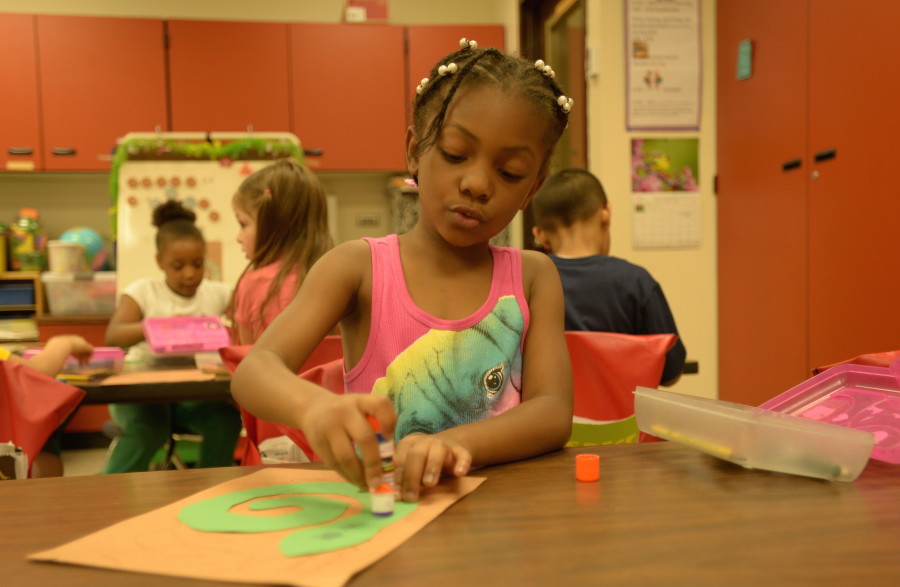 Reading students are “bright, energetic, and motivated,” says 30-year teaching veteran Mitch Hettinger. “They just have the unfortunate circumstance of living in the wrong zip code.”
Reading students are “bright, energetic, and motivated,” says 30-year teaching veteran Mitch Hettinger. “They just have the unfortunate circumstance of living in the wrong zip code.”
But those are the very programs that have been scaled back or cut altogether due to lack of funding in Reading schools, where more than 90 percent of students qualify for free and reduced-price lunch. There simply aren’t enough speech therapists, classroom aides, and ELL tutors to meet current needs. Alternative education programs are gone. Family consumer science was eliminated, though—as one high school teacher points out—many Reading teens could really use the life skills taught there.
Reading only has about half of the school psychologists that it needs to serve 18,000 students. They almost lost their district prekindergarten program, but pressure from parents persuaded the school board to keep it.
That’s something kindergarten teacher Lori Sherman wishes more people knew about Reading. “Our parents really appreciate what we do for their children, which is part of what makes working here very rewarding,” she says. “Many of them don’t have extensive education themselves, but they know how important it is and want their children to get further than they did.”
“One of my close friends went to a wealthier district...she earned $16,000 more per year and had a kindergarten class of 18 with an aide, while I had a class of 30 kindergarteners all on my own. It’s a big difference.”
The question is this: How far can these kids can go if lawmakers don’t take drastic action to make the state’s school finance system equitable? Although Pennsylvania’s graduation rate is nearly 85 percent—among the top 10 in the country—just over half of Reading students earn a diploma.
Inequity in education funding is not unique to Pennsylvania.
Most states’ funding formulas don’t reflect the idea that a K–12 education
should give all children an equal shot at being college and career ready. A recent report by Education Trust found that the highest poverty districts in our country receive on average $1,200 less per student than the lowest poverty districts. Districts serving the largest number of students of color receive about $2,000 less per student than the districts serving the fewest.
Challenging Inequitable School Funding Formulas
We know the strategies that help close achievement gaps: Lower class sizes. A broad curriculum. Attraction and retention of highly qualified teachers. But these strategies are unobtainable without stable, adequate, and equitable funding, says Bruce D. Baker, a professor in the Department of Educational Theory, Policy, and Administration in the Graduate School of Education at Rutgers University.
“Reading is a classic case of savage inequality,” says Baker, referencing the 1991 title by Jonathan Kozol, a searing examination of the two Americas represented by the way we educate our wealthiest and poorest children.
“It’s a school district that is incredibly poor in terms of its own tax base, it has high-needs students, and it exists in a state that appears not to give a [expletive].”
The foundation of Pennsylvania’s school finance system, like those of many other states, is property taxes, which automatically puts Reading—where property values are low—at a huge revenue disadvantage compared to neighboring districts where property values are high. Even when residents in communities like Reading tax themselves at a very high rate, they can’t come close to catching up.
The point of any state’s school finance system is ostensibly to help equalize school district finances from there. But for a variety of reasons, most of them don’t. Pennsylvania doesn’t put enough into its base funding overall, and several other factors hurt disadvantaged communities.
For example, the state distributes a flat amount for special education, almost regardless of how rich or poor a district is and regardless of how many special education students they have proportionally. Pennsylvania also has a minimum aid and a maximum aid share; Reading would get more state aid were there not a cap, and the very wealthy Philadelphia suburb of Lower Marion would get none if there were not a minimum.
Although 70 percent of Reading School District’s budget comes from the state, the amount is simply not enough to achieve equity. And that matters, as Baker explains:
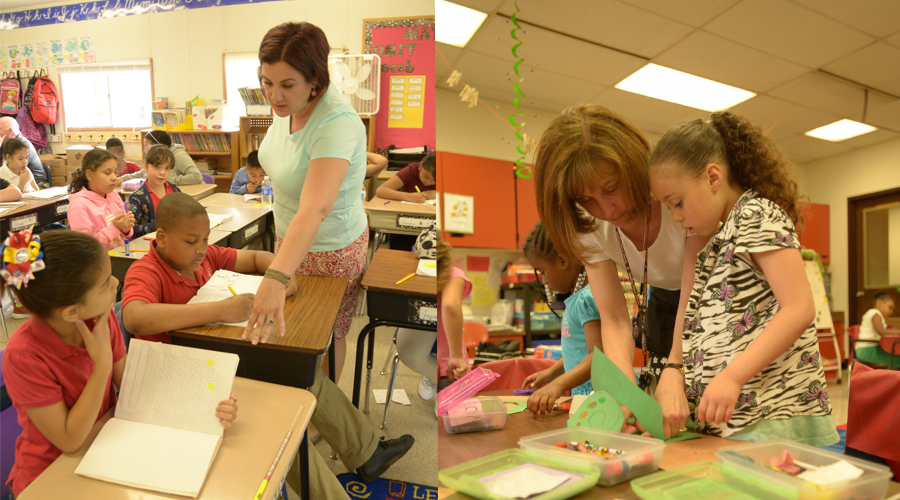 A school day in Reading, Pa.: Students find the answers during Rebecca Titus’ fourth-grade math lesson (left) while Lori Sherman’s kindergarteners enjoy hands-on learning about rainforest animals (right).
A school day in Reading, Pa.: Students find the answers during Rebecca Titus’ fourth-grade math lesson (left) while Lori Sherman’s kindergarteners enjoy hands-on learning about rainforest animals (right).
“There’s not an absolute here, there’s not an exact dollar amount that Reading needs. It’s all relative. Reading needs to be able to compete on the teacher labor market, and their kids need to be able to compete on the college application and labor markets.”
Even if there were agreement among lawmakers that the goal of school finance policy is to provide the resources to offset pre-existing inequalities, as long as wealthy districts with lower-needs students have vastly greater resources, students in Reading will lag far behind in the competition for college and jobs.
Former Pennsylvania Gov. Ed Rendell (2003 – 2011) took a run at addressing these very issues, starting with a study of needs in disadvantaged school districts. Then “he somehow wrangled enough political will to get the legislature to pass a new progressive school funding formula in 2008,” says Baker. Educators in Reading recall the resulting boost in school resources and salaries meant to attract and retain teachers.
But after the 2010 election, the Corbett administration threw out the new formula, returning to regressive funding and slash and burn policies that continue to hurt students in Pennsylvania’s poorer areas.
Data shows we’ve never provided sustained, adequate and equitable funding in any of our disadvantaged communities.”
Things haven’t always been this bad in Reading. When Mitch Hettinger and Lori Sherman were hired in the 1980s, it was “the place to be.” “We had one of the best starting salaries, solid benefits, and a school board zeroed in on academics,” says Hettinger. But in the 1990s, school board brawls and financial mismanagement left the district in a hole that got deeper as the city’s fortunes tanked in the early 2000s.
Unemployment spiked above 13 percent in 2010. Today, nearly 40 percent of Reading lives in poverty, less than 10 percent of residents hold a college degree, and high rates of violent crime persist (about 2.5 times the national average).
Families are exhausted trying to make ends meet. Some must move from place to place as they lose jobs and homes, forcing students to switch schools or accumulate absences.
“You have to understand poverty to teach here,” says Sherman. “That doesn’t mean I lower my expectations. We just have to get creative to meet their needs.”
Reading’s educators regularly dip into their own wallets to buy classroom supplies and instructional materials—some have spent as much as $1,000 per year. The speech pathologists have purchased materials to screen students for services, and the elementary music teacher injured himself building risers—with material he paid for—so that his students could give a proper performance at the end of the year.
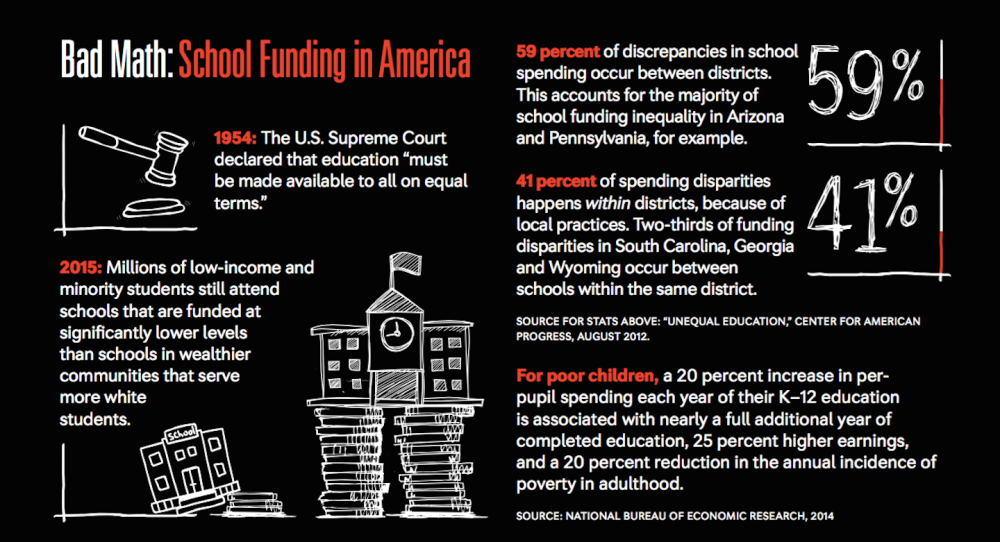 There’s no shortage of dedication and compassion. There’s a shortage of funding that leaves staff and students swimming upstream.
There’s no shortage of dedication and compassion. There’s a shortage of funding that leaves staff and students swimming upstream.
Yet most Reading teachers wouldn’t even think of leaving for a job in a well-funded school just a mile away. “I’ve worked in a suburban setting and a rural setting prior to this,” says Reading fourth-grade teacher Rebecca Titus, “and they were both great districts. But there’s a different kind of joy teaching here because when one of these guys gets it, you know how hard they’ve worked to make it to that point.”
We All Want Fair Funding. Right?
Baker is routinely frustrated by the pundits and policymakers who claim that America “pours money into failing schools.” We aren’t, and we haven’t.
“The data show that we’ve never provided sustained, adequate, and equitable funding in any of our disadvantaged communities,” says Baker. Instead of perpetuating the “public schools as money pit” myth, politicians should tout school finance reform as a way to bolster a state’s economy.
The economic impact of festering achievement gaps is well established. One study shows that if Pennsylvania had closed the gaps that exist along racial and socioeconomic lines in 2003, the state economy could have grown up to 7 percent more last year, netting $44 billion.
To make real progress on equitable funding, everyone who influences school finance must agree that the goal is a progressive formula that will change the equation for high needs districts—from the governor to the state department of education and as many state legislators as possible. And that includes union leaders, too.
The Pennsylvania State Education Association (PSEA) has called for policymakers to reduce the school finance system’s reliance on local property taxes, restore education funding to appropriate levels, and focus on districts with high levels of poverty.
PSEA members also led the outcry against Gov. Corbett’s reckless cuts, elevating education funding as a key issue of the 2014 gubernatorial election. Tom Wolf won handily with equity in education funding a key part of his platform. At press time, Gov. Wolf had just vetoed the budget, which made no meaningful changes to revenues or school funding. It remains to be seen whether he will get much further than former Gov. Rendell on school funding equity in a political climate that is markedly worse.
Why it’s so hard for elected leaders to make progress on equitable school funding confounds local president Mitch Hettinger.
“It’s unfortunate, because these kids are just pawns in all this nonsense.”
____________________________________
Take Action: The people we elect are the only ones who can boost education spending and change our faulty funding system to help close the opportunity gap for kids from low-income communities Find out more.

